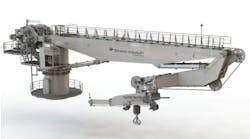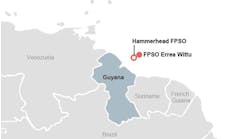Ester based drilling fluids: still the best environmental option?
In 1992, the Sea Based Activities Group (SEBA) of the Oslo and Paris Commission (OSPAR) investigated the impact of oil and gas drilling activities on the North Sea environment. Since that date, rules governing the discharge of oils, chemicals and cuttings have tightened progressively, especially as they relate to the use of traditional oil-based muds (OBM).
Synthetic-based muds (SBM) were developed as alternatives to mineral and diesel-based oil muds for the purpose of reducing the environmental impact of discharging cuttings to the seafloor. However, depending on the type of SBM used, the cuttings piles may not biodegrade quickly enough to meet regulatory standards. If synthetics cannot be used, cuttings re-injection or ship-to-shore transport, treatment, and landfill disposal have become the only options in these cases.
Of the SBMs, esters have been proven to biodegrade more rapidly than other base fluids currently in use. Esters should be considered as an option for drilling in areas where other acceptable disposal methods are unavailable, or result in a significant non-water environmental impact, such as the effects of atmospheric emissions when shipping to shore and carrying out thermal treatment of cuttings.
Mineral oils performance
The development of a low toxicity mineral oil (LTMO) mud provided an improvement on diesel muds, but biodegradability of LTMO cuttings is poor in aerobic conditions and very poor in the anaerobic conditions typically found within a cuttings pile.
The clays and shales in an OBM cuttings pile remain permanently oil-wet, so that hydration does not take place. Thus, the cuttings do not disperse with time, so operators must use other disposal methods such as re-injection or landfill after thermal desorption or encapsulation. Each of these methods has specific environmental risks and operational costs which must be considered.
Further, OBMs may contain aromatic components that can cause tainting in fish and shellfish, making them inedible. Some aromatics used in the mineral oil muds have also been identified as carcinogenic to humans.
SBM development
The problem with OBM cuttings disposal was first recognized as early as 1985. The cuttings piles discharged to the seafloor at that time persisted, continuing to pollute for many years. An alternative to oil-based muds was required. However, any environmentally sound alternative fluid proposed had to offer the excellent technical performance of OBMs as well. The SBMs were designed to retain the key benefits of OBMs, including:
- Borehole stability, especially in sensitive shale formations
- Lubricity
- Mud stability over a range of temperatures and hole conditions
- Absence of reaction with formations.
Development of esters
In 1985, Baroid Drilling Fluids, in alliance with Henkel KgaA (a major German chemical company) began a research program to develop a fully biodegradable base fluid. A number of naturally occurring vegetable and fish oils were tested but these could not meet the drilling performance criteria. Esters were found to be the most suitable naturally derived base fluids, but testing was complicated by the numerous fatty acids and alcohols from which to synthesize esters, each of which had unique physical and chemical properties.
After five years of intensive research, an ester-based mud was ready for field testing. The first trial took place in Norwegian waters. Since then, over 400 wells have been drilled worldwide using the ester-based system, with full approval based on its environmental performance. From a technical standpoint, the fluid provides similar shale stabilization and lubricity to mineral oil mud.
The most recent innovation in ester-based muds is the introduction of a fluid designed to maintain a low viscosity even at the low temperatures encountered in deepwater locations, thus facilitating drilling in these areas by introducing a fluid that can be discharged with cuttings with minimal marine impacts.
Because the ester is naturally derived from palm oil, it degrades rapidly back to fatty acid and alcohol in a hydrolysis process even in anaerobic conditions. At this point, the products of initial degradation biodegrade further to carbon dioxide and water.
Testing ester-based fluids
The solid phase biodegradation test closely mimics the seafloor sediments and allows for testing under both anaerobic and aerobic conditions. The results of this test showed that the amount of esters in the cuttings decreased by 50% after 28 days and was reduced to almost zero in 120 days.
The NIVA Test was developed by the Norwegian Institute for Water Research. A 1999 analysis of biodegradation studies found that the "ecologically relevant" results of the NIVA test "were interpreted to say that ester degraded much faster than the rest of the materials tested and was therefore identified as the best fluid for the environment" (Candler, 1999).
Seabed surveys
Unlike other oil or synthetic-based fluids, the biodegradation of ester-based fluids continues in the absence of oxygen, allowing water wetting of shale and clay cuttings, and thus facilitating cuttings pile dispersion. Seabed surveys conducted where esters have been used for drilling, show that in terms of species diversity and number, and total abundance of individuals, recovery is apparent one year after drilling has ceased.
After two years, little evidence of disturbance to the seabed ecology may be detected. Further, esters pose no known human health hazard, proven by extensive laboratory and field trials.
Discharging not optional
Other disposal options involve, where regulations permit, re-injection of cuttings at the wellsite or ship-to-shore transport followed by treatment and subsequent disposal at landfills. Certain hazards are involved with shipping cuttings to shore, especially under adverse weather conditions. Onshore, disposal space is becoming limited and costs are climbing. The high salt content of the cuttings also contributes to restrictions as to where and how the cuttings can be disposed of.
Long term liabilities of disposal onshore are also of increasing concern to many operators. Non-water quality issues, such as land contamination or increased carbon dioxide and other air emissions are also increased when compared to disposal at sea.
In many areas, cuttings generated while drilling with OBMs or non-ester SBMs cannot be discharged to the seafloor. Under these conditions, the most cost effective disposal method is often the re-injection of cuttings. The decision to use this method must be early in the operation, as an injection zone must be identified and evaluated.
Some cases of breaching to surface have been known to occur, and as monitoring of surfaces above injection sites may be difficult. Every effort must be made to ensure the injection zone remains competent. Generally, the injection takes place at the same wellsite where the cuttings are generated, as inter-field transportation of cuttings may not be legal or feasible in some areas.
Thermal desorption, landfill
This process involves shipping cuttings to shore and distilling off base oil from those cuttings in order to "clean up" the cuttings. Many currently available mineral oils may "crack" when exposed to the high temperatures of the thermal desorption process, resulting in a significant lowering of the flash point and the production of n-hexanes which are dangerous to human health. Residual salt present in cuttings can also pose a problem, making their use in construction projects impractical.
Encapsulation and landfill disposal requires transportation of cuttings to shore and on to a treatment area. The cuttings are fixed in cementitious material such as cement or fly ash, then sent to a landfill for disposal. The process significantly increases the disposal volume, requiring more landfill space.
Safety and environmental issues of transfer, transport and long term liabilities apply in this case. Low bulk alternatives have been proposed, but their efficiency in treating drill cuttings has yet to be proved.
Landfarming
Spread onto land, the cuttings may improve soil quality, but must be monitored over the long term for changes. Cuttings may require pre-treatment and compatibility between the drilling system and soil must be determined. High salt content can harm soil productivity. Safety and environmental issues of transfer and transport also apply.
Composting as a solution involves the mixing of cuttings with organic materials to dilute out the oil content and enhance speed of biodegradation of drilling fluids. The process requires controlled temperature and moisture levels and may require an excessively long period of time in colder climates, unless some form of heating can be used.
Composting is not a quick solution and may require long periods of time to reduce the oil content if cheaper and less biodegradable base oils are used. Transport of the cuttings to a suitable site and continued maintenance of the biopiles may make this approach prohibitively expensive in some cases. Salt content can reduce biological activity and thus slow the process, and long-term liability of cuttings disposal is an important consideration.
Conclusions
There are several options for disposing of drill cuttings, depending on local rules, agency regulations, and the type of drilling fluid used. The decision about which method to use should be based on several factors:
- Overall environmental effects, including the costs of shipping to shore (fuel, onshore treatment, increased traffic and increasingly limited landfill sites)
- Human safety factors, including mechanical handling of cuttings boxes, increased traffic, and personnel safety during treatment
- Logistical problems, including equipment failure, weather and sea conditions, and disruption of drilling due to inability to transport cuttings.
At present, the cheapest disposal option is wellsite re-injection, as long as this process is allowed under local regulations, if injection zones can be identified and no breaching occurs. In contrast, ester fluids disposal at sea also minimizes emissions to air and eliminates any impact to land disposal sites, unlike the option of shipping and treatment of cuttings. Until all of the environmental impacts of the various disposal technologies are understood, the option to discharge ester-based fluids, in many cases, is considered the current best available technology.;
References:
Candler, J., Rabke, S., Leuterman, A., "Predicting the Potential Impact of Synthetic-Based Muds with the Use of Biodegradation Studies." 1999 SPE/EPA Exploration and Production Environmental Conference, Austin, Texas, February-March, 1999, SPE 52742.
Norman, M., "Esters: The Only Synthetic Option for the Next Millenium?" 5th IBC International Conference of Minimising the Environmental Effects of Drilling Operations, Aberdeen, September 1997.



